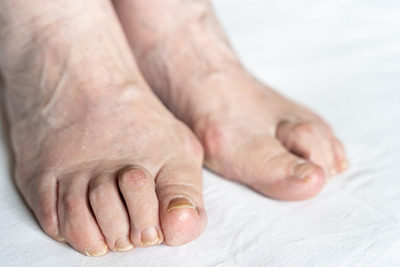
Hammertoes are a common foot condition that can affect anyone. They're characterized by an abnormal bending of the toe joint, causing the affected toe to resemble a hammer. You could have hammertoes if you notice your toe(s) curving downward rather than lying flat.
Hammertoes typically develop due to imbalances in the muscles, tendons, and ligaments that hold the toes in place. Hammertoes can result from wearing tight shoes and high heels or be an inherited tendency. In the early stages, hammertoes might be flexible and easily corrected by straightening the toe. However, if left untreated, they can become rigid, making moving challenging and painful.
If you're experiencing discomfort, corns, calluses, or have difficulty finding shoes that fit comfortably due to a hammertoe, it's time to consider seeking help. Dr. Gary Rogers at Wilmette Foot and Ankle Clinic in Wilmette, IL, specializes in diagnosing and treating foot conditions like hammertoes. He can provide non-surgical options, like orthotic devices and physical therapy or surgical solutions for severe cases.
Hammertoes: Explained
Hammertoes are a common foot condition that can affect your toes, causing them to bend or curl abnormally. Imagine your toe starts to resemble a hammer, with the middle joint bending upwards while the tip points downward. It's like your toe gets stuck in a perpetual, uncomfortable contraction. These twisted toes can be painful, making walking or wearing shoes impossible. They often result from muscle imbalances, genetics, or wearing tight-fitting shoes. The second, third, and fourth toes are usually most affected.
Dr. Rogers offers a range of services for hammertoes in Wilmette, IL. These include thorough diagnosis through physical exams and X-rays to assess severity. Treatment options vary from lifestyle modifications, like wearing proper footwear and using orthotic inserts, to exercises for improved flexibility. In more severe cases, they may employ splinting, strapping, or recommend surgery to reposition or release affected tendons. Dr. Rogers tailors treatment to individual needs to alleviate discomfort and improve foot function.
Hammertoes: Diagnosis and Treatment
Dr. Rogers employs a comprehensive approach to diagnose and treat hammertoes, ensuring comfort and mobility. Dr. Rogers begins with a thorough physical examination to identify hammertoes in Wilmette, IL. He checks for visible deformities, assesses your range of motion, and evaluates associated pain or discomfort. Once diagnosed, Dr. Rogers tailors a treatment plan to your specific needs. He might suggest lifestyle adjustments, like wearing roomier shoes and using orthotic inserts in some cases. If your condition is more severe, he may recommend splinting, strapping, or exercises to improve toe flexibility. Surgery might be necessary to reposition or release the affected tendons.
Please explore our website to learn about the conditions we treat and the services provided. Pain-free days are possible. Discover the root of discomfort with our advanced foot and ankle X-rays to diagnose and treat hammertoes in Wilmette, IL. To schedule an appointment with Dr. Gary Rogers at Wilmette Foot and Ankle Clinic, call (847) 256-4434.
